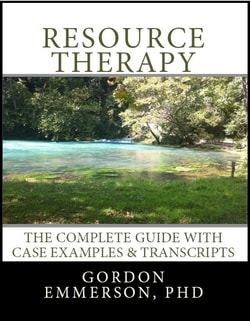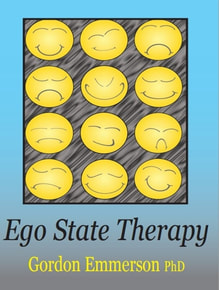

Key Differences in Resource Personality Theory and Therapy and
Ego State Personality Theory and Therapy
Several important distinctions exist between Resource Personality Theory (also known as Advanced Ego State Therapy) and the Theories of John and Helen Watkins (1997) and their Ego State movement. Both are excellent therapeutic approaches, and both are based on the assumption that the personality is composed of parts.
Differences between Resource Therapy and Ego State therapy
- Hypnosis: Resource Therapists hold that the use of the treatment Actions provides a sufficient level of focus for therapeutic change, while Ego State Therapists have traditionally used hypnotic inductions.
- Introjects: Resource Therapists see Introjects as internalized impressions empowered only by the Resource States that hold them, while Ego State Therapists see them as Ego States (this difference is key in the treatment).
- States holding trauma: Resource Therapists believe internal protagonists are powerless memory fragments and to fight them is to empower them. Resource Therapists help the client to gain an understanding that they have no internal power. Ego State Therapists help clients fight internal protagonists.
- Diagnostic Criteria: Resource Therapy has diagnostic criteria for 8 pathological conditions and 15 corresponding Treatment Actions. Ego State Therapy does not have distinct diagnostic criteria for state conditions.
- The Nature of the States: Resource Therapists believe personality parts are Resources that developed as coping skills and therefore each is a tool that can be useful, while Watkins saw personality parts developing from the personality splitting; “split off from the core ego because of trauma” (Watkins & Watkins, 1997, pp. 26).
The Watkins saw personality parts developing from the personality splitting; split off from the core ego because of trauma (Watkins & Watkins, 1997) pp.26).
Conversely, Resource States are seen to develop when coping skills are needed. These personality parts physically develop over a significant amount of time by the behavioral training of the axon/dendrite / synaptic connections. The brain grows according to the amount and type of stimulation it receives and this is how our distinct Resource States develop.
In Resource Personality Theory a personality part is an existing personality part that has developed normally over time in our brains. It does not develop from trauma. Our parts exist in a normal condition, however, circumstances can lead them to be traumatized. When this part receives the correct RT therapeutic intervention it will again return to its healthy normal state and assume its original coping function.
Introjects
Many Ego State Therapists see Introjects as personality parts that may be worked with so they can change into better personality parts. They work with Introjects to change their nature. They believe Introjects sometimes become ‘Ego States’.
Conversely, in Resource Theory, Resource States are the only actual personality parts.
As evidence for this, Bridging will never go to an Introject. Introjects are seen as the internalized impressions of others, held by Resource States. They can be persons, animals, or inanimate. For example, a separate internalized impression (Introject) of the Father is held by each Resource State. The Father Introject of a child state may be seen as scary, but the Father Introject of an adult state may be seen as helpful.
Resource Therapists do not attempt to work with Introjects to change them. Resource therapists with the client’s Resource States to empower the state and assist it to understand that the past is past, and the negative Introjects of the past have no power in the present. Just like actors can pretend to be the roles they play, a Resource State can pretend to be one of its Introjects, but the Introject is still merely an impression. Using RT Action 5, Introject Speak (See RT Treatment Page), a Resource State can speak as an Introject to attain a higher level of understanding about why the state was treated in the manner it was by the Introject.
An Ego State Therapist might attempt to change a negative ‘Mother’ Introject into a positive ‘Mother’ Introject. Conversely, A Resource therapist would empower the Resource State to understand that it is not responsible for the negative behavior of someone else and would bring to the Conscious other inner Resources of the client to ensure the state that had felt disempowered or rejected gains a feeling of empowerment, support, and understanding. A state that remembers ‘Mother’ as detached can keep that impression, but becomes empowered by gaining the understanding that it has a value separate from the impression it holds of ‘Mother’.
There are two types of introjects, internalized impressions held by Resource States, and the much more rate, Other Personalized Introjects (OPIs). The personality is dynamic and fascinating, as evidenced by the occasional presentation of an OPI. OPIs are occasional personality expressions that, 1) claim not to be a part of the person and, 2) say they are not where they belong.
Some Ego State therapists point to a person with an Introject that appears to act like a Personality Part as an indication that an Introject can become a real personality part. Resource Therapists call these Introjects, OPIs. When spoken with directly they will claim not to be a part of the personality, unlike Resource States, and they can permanently leave the personality. A therapist can ask a Resource State to leave (I do not recommend it, as all Resource States should gain a positive function with the personality) but it will always be there during following sessions, if it is asked to speak. After an OPI can leaves it will not be present again.
OPIs will also often say they do not want to leave. While their etiology is unclear, I find when they are negotiated with to leave they can do so without any further indication of being present. Clients will show improvement and often say they feel physically lighter.
In summary, Resource Therapy and Ego Stae Therapy have many similarities. They are both powerful therapies that focus on cause rather than symptoms, and they both work with personality parts, but they have some core differences in theory, practice, and in who can be trained.
